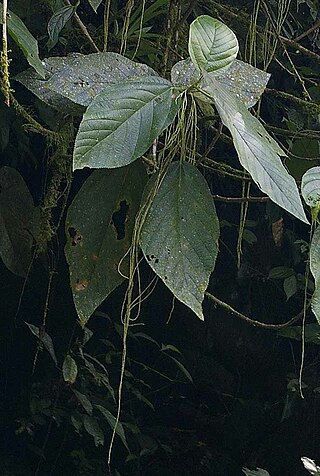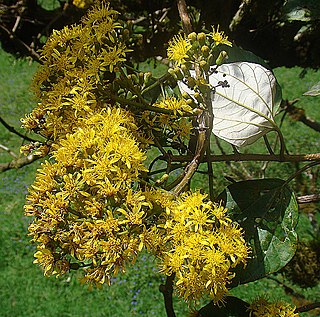
George Bentham was an English botanist, described by the weed botanist Duane Isely as "the premier systematic botanist of the nineteenth century". Born into a distinguished family, he initially studied law, but had a fascination with botany from an early age, which he soon pursued, becoming president of the Linnaean Society in 1861, and a fellow of the Royal Society in 1862. He was the author of a number of important botanical works, particularly flora. He is best known for his taxonomic classification of plants in collaboration with Joseph Dalton Hooker, his Genera Plantarum (1862–1883). He died in London in 1884.

HMS Sulphur was a 10-gun Hecla-class bomb vessel of the British Royal Navy, famous as one of the ships in which Edward Belcher explored the Pacific coast of the Americas.

Myriocarpa is a genus woody plant which ranges in size from shrubs to small trees and is endemic to Central and South America. Within the Urticaceae, Myriocarpa is characterized by long pendulous string-like female inflorescences of apparently naked flowers and stems which release a watery latex when cut. Estimates for the diversity of the genus range from five to eighteen species. Research for Flora Mesoamericana indicates that there are probably fifteen to twenty species.

Perityle is a genus of flowering plants in the daisy family. They are known generally as rock daisies.

Hofmeisteria is a genus of Mexican flowering plants in the family Asteraceae.
Gouinia is a genus of Latin American plants in the grass family.
Amauria is a genus of flowering plants in the family Asteraceae described as a genus in 1844.

Sinclairia is a genus of Latin American plants in the tribe Liabeae within the family Asteraceae.

Iostephane is a genus of Mexican flowering plants in the family Asteraceae.
Otopappus is a genus of flowering plants in the tribe Heliantheae within the family Asteraceae, primarily Mesoamerican but with one species from Jamaica.
Stachycephalum is a genus of plants in the family Asteraceae.

Podachaenium is a genus of Mesoamerican plants in the tribe Heliantheae within the family Asteraceae.
Coreocarpus is a genus of flowering plants in the family Asteraceae native to northwestern Mexico and southern Arizona.

Tillandsia variabilis, the leatherleaf airplant, is a species of bromeliad in the genus Tillandsia. This species is native to Bolivia, Costa Rica, Mexico, Venezuela, Colombia, the West Indies and southern Florida.

Heliconia latispatha is a plant species native to southern Mexico, Central America and northern South America and naturalized in Florida and Jamaica. It is an herbaceous perennial up to 4 m tall, with leaves resembling those of bananas. The inflorescence is erect, up to 45 cm long, with red or orange bracts subtending green, yellow or orange flowers.
Berberis lanceolata is a shrub in the Berberidaceae described as a species in 1840. It is endemic to Mexico, found in the States of Hidalgo, Oaxaca, Veracruz, and Puebla.
Berberis andrieuxii is a shrub in the Berberidaceae described as a species in 1838. It is endemic to the State of Oaxaca in southern Mexico.
Berberis pallida is a shrub in the Berberidaceae described as a species in 1840. It is endemic to Mexico, known from the States of Guanajuato, Hidalgo, Oaxaca, Veracruz, Puebla, Querétaro, and Tamaulipas.

Brickellia hastata is a North American species of shrubs in the family Asteraceae. It is found only in the state of Baja California Sur in western Mexico.
Richard Brinsley Hinds FRCS was a British naval surgeon, botanist and malacologist. He sailed on the 1835–42 voyage by HMS Sulphur to explore the Pacific Ocean, and edited the natural history reports of that expedition.









